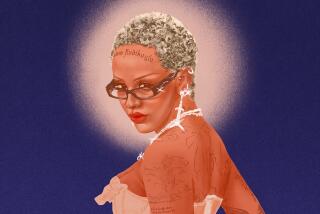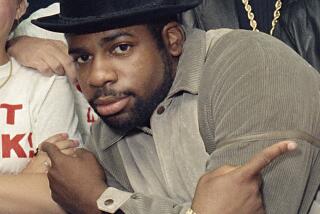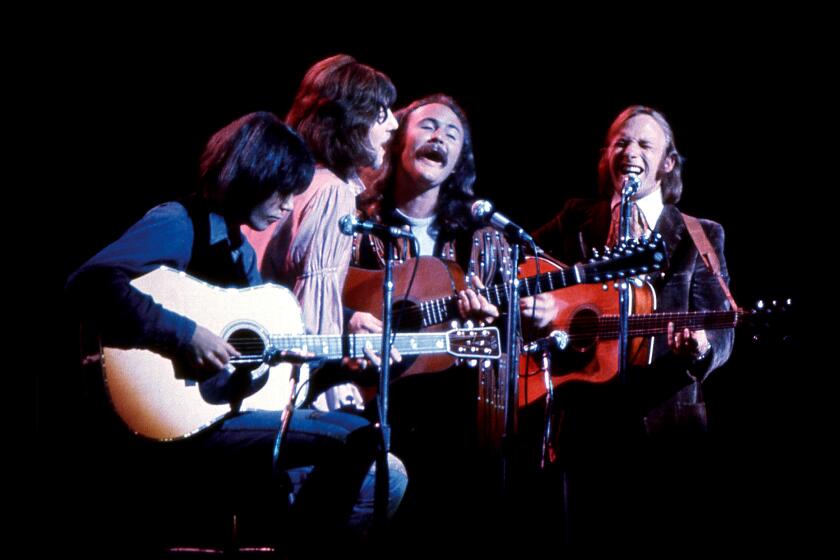Re-Walking the Walk
- Share via
You’d hardly expect three guys with millions of record sales and a legendary reputation in rap to select the cramped confines of a rental car as the setting for an interview--even if we’re talking a Lincoln.
But here are the members of Run-DMC, sitting in the car in a West Hollywood parking lot on a Sunday afternoon.
They’ve chosen to do the interview here because Run and Jam Master Jay are due shortly at a recording session in the San Fernando Valley with fellow rap pioneer Scarface, and they’ll want to make a quick getaway.
If you had caught up with the trio 13 or so years ago, they might have selected a rental car for another reason: a straight shot to the airport.
Run-DMC may be widely hailed today as rap pioneers who persuaded a skeptical music industry that rap was a genuine art form and demonstrated the compatibility of rock and rap with their remake of Aerosmith’s “Walk This Way.”
But they must have felt under attack around the country--and especially in Los Angeles--in the mid-’80s when they were at the forefront of the first wave of public hostility toward this outspoken new pop music form.
Even before violence broke out during a Run-DMC concert at the Long Beach Arena on Aug. 17, 1986, some parents and civic authorities were beginning to wonder if rap was having a negative impact on young people. Years before the arrival of N.W.A and the explosive gangsta rap style, people were uneasy about Run-DMC because of their black hats and black outfits.
The opposition escalated dramatically after the Long Beach concert, where some 40 fans were injured during an outbreak of gang violence. The group’s show the following night at the Hollywood Palladium was canceled, and other venues were suddenly reluctant to book any rap act.
The concern wasn’t limited to Southern California. Three Run-DMC shows in the South were also quickly canceled, and metal detectors were installed at venues in numerous cities, including Portland, Ore., and Columbia, S.C.
Now the trio is matter-of-fact when looking back at the tumult.
“We were a little disgusted with the [concert-goers] for actually doing that,” Jam Master Jay (born Jason Mizell) says. “Before the media [blew it out of proportion], we were mad at the people for just being stupid enough to start hurting up little kids. People come to see us to have a good time, and the situation just turned out to be extra negative.”
Eventually, Run-DMC resumed a normal schedule and saw much of the controversy shift to newer and far more volatile rap forces, including N.W.A, 2Pac and the Notorious B.I.G.
Though the trio’s sales slumped in the ‘90s, the three continued to tour, and they are looking forward to their third decade with renewed enthusiasm. One reason for their optimism: a new album that features guest appearances by many of today’s hottest rap and rock outfits, including Method Man and Limp Bizkit.
That kind of collaboration brings things full circle for the group, which teamed with Aerosmith on the breakthrough “Walk This Way.” Some things just don’t seem to change.
“When we first got on MTV [with “Rock Box”], everybody else got so excited,” says DMC (Darryl McDaniels). “We were like, ‘What’s MTV?’ All of the successes that came from that seemed more important to other people than it was to me.
“Right now, the business is so big that you’re living up to other people’s expectations. I come up with my lyrics, ideas and prepare myself in the same innocent way that I prepared them in my bedroom before I ever thought I was going to rap.”
*
Modesty hardly ranks among Run-DMC’s chief qualities. Throughout the interview, Run (born Joseph Simmons), especially, is quick to boast about the group’s history.
But they are, after all, Run-DMC, so some chest-thumping can be excused. Indeed, they came up in a time when egocentric raps were status quo. In fact, the boasts could be seen as defiance toward the forces that said the genre would disappear.
Since its debut release in 1983, the double-sided single “It’s Like That” and “Sucker M.C.’s,” the trio from Hollis, Queens, has been among hip-hop’s most recognizable forces. One person the group had in its corner was Run’s brother Russell, its manager and the co-founder of Def Jam Records. In fact, Russell was the businessman most responsible for opening doors in the industry for rap artists.
The utter confidence that resonated through Run-DMC’s brag-heavy music might have been a key reason for its longevity.
“We felt that we could be doing it as long as anyone else was doing it up to that time,” Run, 34, remembers. “When our records first hit, we thought we’d keep making them forever. We thought we were good and that we’d never make anything that was wack.”
And for a long time, they didn’t.
Their “Walk This Way” collaboration with Aerosmith was a crossover smash that reached No. 4 on the pop charts, helping their 1986 album “Raising Hell” sell more than 4 million copies--a then-unprecedented number for a rap group.
Their rock-rap hybrid cleared the way for everyone from the Beastie Boys to Limp Bizkit. Other songs from the album, such as “Peter Piper,” “It’s Tricky” and “My Adidas” are classics that were embraced by hip-hop fans across the country.
“What was great about Run-DMC was their consistency,” says Billy Johnson Jr., rap and R&B; editor of the CD-ROM magazine Launch. “From the first time that I heard them, their music was infectious and hard. It was the epitome of hip-hop, and they delivered it nonstop for several years. No one could touch Run-DMC.”
Their success continued with 1988’s “Tougher Than Leather,” although sales dipped to about 2 million. As younger and more aggressive rap voices emerged, the sales drop-off continued with 1990’s “Back From Hell,” which sold about 500,000 and was widely considered its weakest effort.
That was the first time that the trio’s artistry was questioned by hip-hop fans, and the disfavor continued with 1993’s “Down With the King.” One problem with the two albums was that they seemed to be trying to sound like their competitors rather than break new ground.
Though the group has continued to tour, its profile has been so low in recent years that the casual rap fan may have thought it had retired.
But Run and the others scoff at the notion that their upcoming album is any sort of return.
Says Run, “The album is going to be a big hit. This isn’t a comeback album.”
However you view it, rap observers will be closely watching “Crown Royal,” the group’s first album in six years, just to see if the self-proclaimed “Kings From Queens” really wear a crown.
The veteran crew is so pleased with the album that they can’t resist playing it over the car stereo as they sit in the Pacific Design Center parking lot.
The collection--which will be released by Profile Records, a former independent that is now affiliated with Arista Records--contains some tracks with the rock-rap sound the group helped create, and some with more of the hard-core hip-hop style that was also a Run-DMC signature.
To ready themselves to record the album, which is due Nov. 16, the group returned to its creative home.
“I felt like I needed to be around the kids, so I hung around Jay’s studio on Jamaica Avenue [in Queens],” says Run, an ordained minister who lives with his wife and five children in Queens. “I prepared myself by taking note of whatever I didn’t know, the new things happening [with the kids].
“If you think you know it all, you’ll fail. It’s about getting [together] with the hungry cats, the cats that have the vibe perfectly. I don’t think I know because I once knew.”
*
On the album, Run and DMC include vocal flows that sound light-years beyond the simple, straightforward ones they once employed. Other collaborators include such contemporary hip-hop luminaries as Ol’ Dirty Bastard, Nas and Mobb Deep’s Prodigy.
But it’s the high-energy cuts with rockers Limp Bizkit, Sugar Ray and Kid Rock that are likely to spark the most commercial interest, much as “Walk This Way” once did.
“Collaborations are hot right now,” Jay says. “I love doing collaborations. People want to do songs with us and we want to do songs with [other] people.”
Run agrees. “We felt like we wanted to put these people on the album. I had fun putting them on the album. I think they enhanced the record. We didn’t make straight Run-DMC records. It ain’t the same time it was. It’s going to be a hot album though, very hot. It’s going to be big, real big.” *
More to Read
The biggest entertainment stories
Get our big stories about Hollywood, film, television, music, arts, culture and more right in your inbox as soon as they publish.
You may occasionally receive promotional content from the Los Angeles Times.










